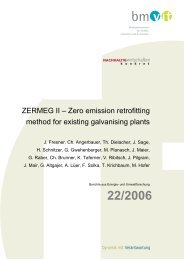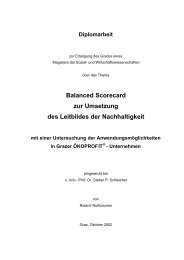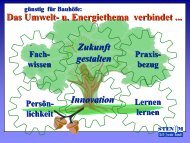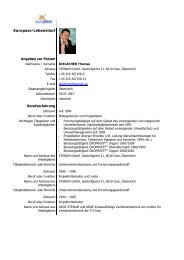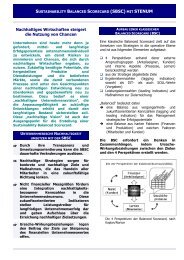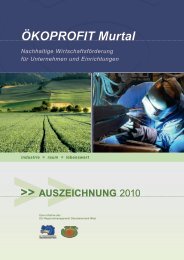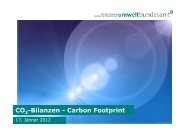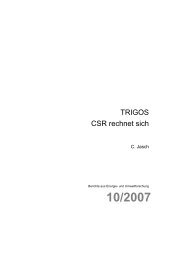Promoting Resource Efficiency in Small & Medium size ... - UNEP
Promoting Resource Efficiency in Small & Medium size ... - UNEP
Promoting Resource Efficiency in Small & Medium size ... - UNEP
You also want an ePaper? Increase the reach of your titles
YUMPU automatically turns print PDFs into web optimized ePapers that Google loves.
• Waste <strong>in</strong>c<strong>in</strong>eration<br />
Inc<strong>in</strong>eration of waste m<strong>in</strong>eralises it and reduces the volume of solid<br />
residuals. Inc<strong>in</strong>eration results <strong>in</strong> the output of other waste streams<br />
such as: air emissions, ash, slag, heat, etc. that should be treated<br />
separately.<br />
Types of controlled <strong>in</strong>c<strong>in</strong>eration processes <strong>in</strong>clude:<br />
- Low-temperature (municipal) waste <strong>in</strong>c<strong>in</strong>erators<br />
- High-temperature waste <strong>in</strong>c<strong>in</strong>erators<br />
- Cement kilns<br />
• Sanitary landfill<br />
Sanitary landfills provide outlets for the ultimate disposal of<br />
waste generated. A sanitary landfill is a controlled area of land on<br />
which waste is disposed of, <strong>in</strong> accordance with standards, rules or<br />
orders established by a regulatory body. Waste material is placed<br />
<strong>in</strong> trenches or on land, compacted by mechanical equipment and<br />
covered with earth and a f<strong>in</strong>al cover.<br />
With<strong>in</strong> the category of sanitary landfill three technologies can be<br />
dist<strong>in</strong>guished:<br />
- Bioactive sanitary landfills – The material is of non-m<strong>in</strong>eral<br />
quality. It is reactive and therefore needs extensive control<br />
systems cover<strong>in</strong>g the operational, closure and post-closure<br />
phase. The chemical composition of the residues is not known<br />
(sludges from mixed waste water treatment, mixed laboratory<br />
waste).<br />
- Sanitary landfills for stabilsed residues – Similar to bioactive<br />
sanitary landfills, but for materials that will not form either<br />
gases or water-soluble substances when <strong>in</strong> contact with water,<br />
air or other stabilised residues. The chemical composition of<br />
the residues is well known (household residues after separat<strong>in</strong>g<br />
biowaste, plastics, paper).<br />
- Sanitary landfills for <strong>in</strong>ert materials – The material is <strong>in</strong>ert.<br />
Therefore the landfill needs no control systems dur<strong>in</strong>g the<br />
operation phase, closure and post-closure phase (concrete).<br />
• Open dumpsite<br />
An open dumpsite is an uncontrolled area of land on which waste is<br />
disposed, either legally or illegally.<br />
• Special cases: Pre-treatment and temporary on-site<br />
storage of waste<br />
- Pre-treatment processes prepare waste for <strong>in</strong>c<strong>in</strong>eration or<br />
landfill. For the purpose of this manual, pre-treatment does not<br />
constitute a separate category of waste treatment technology.<br />
Waste that undergoes external pre-treatment is dealt with under<br />
waste <strong>in</strong>c<strong>in</strong>eration and landfill. If the path is not known and<br />
documented, landfill is assumed.<br />
- Temporary on-site storage<br />
- Waste that is temporary stored on-site and for which the<br />
treatment technology is not yet known constitutes a separate<br />
category of waste treatment technology. The report<strong>in</strong>g entity<br />
should give special attention to <strong>in</strong>clude adequate <strong>in</strong>formation<br />
on the technology used and the processes <strong>in</strong>volved <strong>in</strong> on-site<br />
storage.<br />
7.2 WHY:<br />
Waste m<strong>in</strong>imisation benefits for SMEs<br />
7.2.1 Contam<strong>in</strong>ated land<br />
As early as 1996, a worldwide survey by <strong>UNEP</strong> showed that all countries<br />
are susceptible to land contam<strong>in</strong>ation from a wide range of <strong>in</strong>dustrial<br />
activities. Household waste <strong>in</strong>creas<strong>in</strong>gly conta<strong>in</strong>s chemical residues<br />
from domestic clean<strong>in</strong>g and other products. It should be stressed that<br />
because of the high cost of remediation of contam<strong>in</strong>ated land, pollution<br />
prevention programmes are a preferred strategy for waste management.<br />
7.2.2 Waste concerns 61<br />
Collect<strong>in</strong>g, recycl<strong>in</strong>g, treat<strong>in</strong>g and dispos<strong>in</strong>g of <strong>in</strong>creas<strong>in</strong>g quantities of<br />
solid waste and wastewater rema<strong>in</strong>s a major challenge for developed<br />
and develop<strong>in</strong>g countries alike.<br />
Grow<strong>in</strong>g landfills around the world mirror the global trends of <strong>in</strong>creas<strong>in</strong>g<br />
population, prosperity and urbanisation. What is more worry<strong>in</strong>g is<br />
excessive waste generation itself: f<strong>in</strong>ite resources are transformed <strong>in</strong>to<br />
s<strong>in</strong>gle-use, GHG-emitt<strong>in</strong>g goods that all too quickly end up <strong>in</strong> landfills.<br />
At the same time, there is a grow<strong>in</strong>g realisation that waste can be a<br />
resource too.<br />
Overall, the waste sector contributes less than 5% of global GHG<br />
emissions. The largest source is landfill methane (CH 4<br />
), followed<br />
by wastewater CH 4<br />
and nitrous oxide (N 2<br />
O). Nitrous Oxide (N 2<br />
O)<br />
contributes to climate change; a major source is human sewage and<br />
emissions that occur dur<strong>in</strong>g the wastewater treatment process. Methane<br />
is also emitted dur<strong>in</strong>g wastewater transport, sewage treatment processes<br />
and leakages from anaerobic digestion of waste or wastewater sludge.<br />
In addition, m<strong>in</strong>or emissions of carbon dioxide (CO 2<br />
) emerge when<br />
waste conta<strong>in</strong><strong>in</strong>g fossil carbon is burnt (e.g. plastics; synthetic textiles)<br />
and by the non-biomass portion of <strong>in</strong>c<strong>in</strong>erated waste. Open burn<strong>in</strong>g of<br />
waste <strong>in</strong> develop<strong>in</strong>g countries is a significant local source of air pollution,<br />
constitut<strong>in</strong>g a health risk for nearby communities. Compost<strong>in</strong>g and other<br />
biological treatments emit very small quantities of GHGs. It is worth<br />
not<strong>in</strong>g that landfill emissions cont<strong>in</strong>ue several decades after the waste<br />
is disposed <strong>in</strong> them, which makes it difficult to estimate emission trends.<br />
61) <strong>UNEP</strong>, Climate Neutral Network, Waste, undated<br />
66





